Traditional Chinese Architecture 建筑 Jiàn zhù
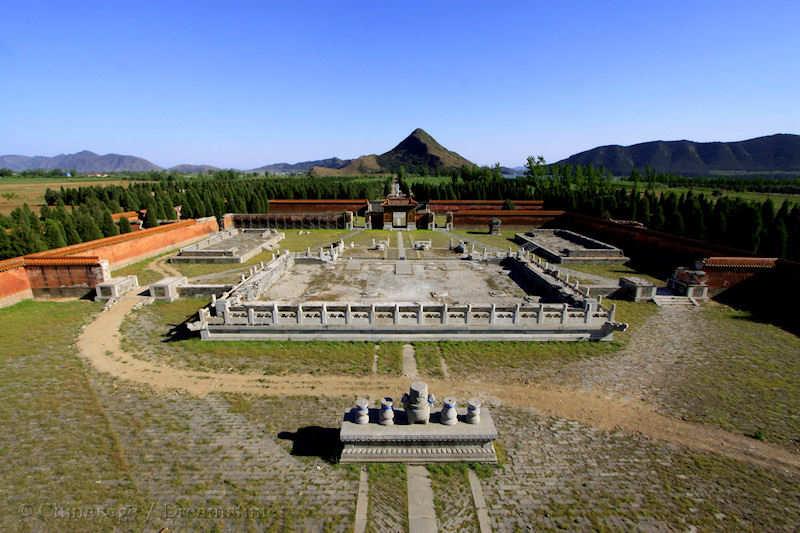
The main feature of traditional Chinese architecture has been its stability; styles did not change much over many centuries. In Europe, styles came in and out of fashion and so it is easy to guess the date of a building to within a century, this is not so easy in China.
Only a few ‘ancient’ buildings in China date back further than the Ming dynasty due to their mainly wooden construction. Tourist sites that are described as ‘Han’ or ‘Tang’ dynasty have in the main, although retaining the original design, been completely rebuilt in the last few centuries. Some of those that have survived intact include the Nanchan Temple ➚; Foguang Temple ➚, Shanxi (Wutai mountain) and there are also buildings of Tang dynasty date and design in Japan.
Proper placement of a building in the landscape has always been important. Traditionally a Feng Shui consultant would advise on the most auspicious position and outlook. Generally a building should face south and so receives the most warmth and light.

Courtyard houses (四合院 sìhéyuàn)
The traditional house design is based around a courtyard. Chinese houses (宅院 zhái yuàn) normally comprised a main residence flanked on two sides by walls and smaller rooms to form an enclosed courtyard. The windows and doors open onto the courtyard (庭 tíng) rather than the exterior. It was designed for the occupation of an extended family, typically three generations. The courtyard houses siheyuan are surrounded by narrow lanes in Beijing laid out as a grid network called 胡同 hú tòng and areas of ancient housing are often called hutongs because of this; elsewhere the lanes are called longtangs ➚ and grew up as winding networks with no overall symmetry.
The tradition is inside-out compared to western styles. This was partly to create an intimate, quiet, private family space and partly to hide the wealth of the family. People, particularly merchants, would face opprobrium if they showed off their wealth. The inner, private space of the courtyard was the only place where this could be done.
Larger and grander houses have courtyards nested within larger courtyards following the same design. The courtyard is flanked on all sides by halls linked by covered walkways (廊 láng). All houses were built symmetric around a central north-south axis. The evidence that this style of architecture goes back at least to the Han dynasty comes from clay models of houses that have been found in tombs, so the courtyard design is over two thousand years old. In southern China the buildings rose to two floors, while in the north typically only one. This is partly explained by the belief that helpful spirits flew not far above the ground and so high buildings would block their path but more likely because northern China is subject to powerful earthquakes. The prime dwelling space was on the first floor of the south facing building. It was here that the senior members of the extended family (the paternal grandfather and grandmother) usually lived. In the more prosperous families, each family group would occupy a separate courtyard.

The main gateway entrance into the courtyard house had two red doors that were located on the eastern part of the south side conforming to the rules of feng shui. Immediately behind the entrance was a solid, screen wall ‘照壁 zhào bì’ (Spirit Wall) that denies direct view or access to the courtyard, it was also to keep out the evil spirits (and cold winds too). The largest example of a wall of this type is the Nine Dragon Wall in Beijing made from brightly colored glazed tiles. The entrance hall opened into a front courtyard which had the formal entrance into the main courtyard on its north side. In high status houses the servant quarters lie to the north of (behind) the main building. A grander design may have had watch towers at the corners. As the courtyard design was standard to all it was the decoration of the entrance and internal rooms that gave each house its individuality.
Windows
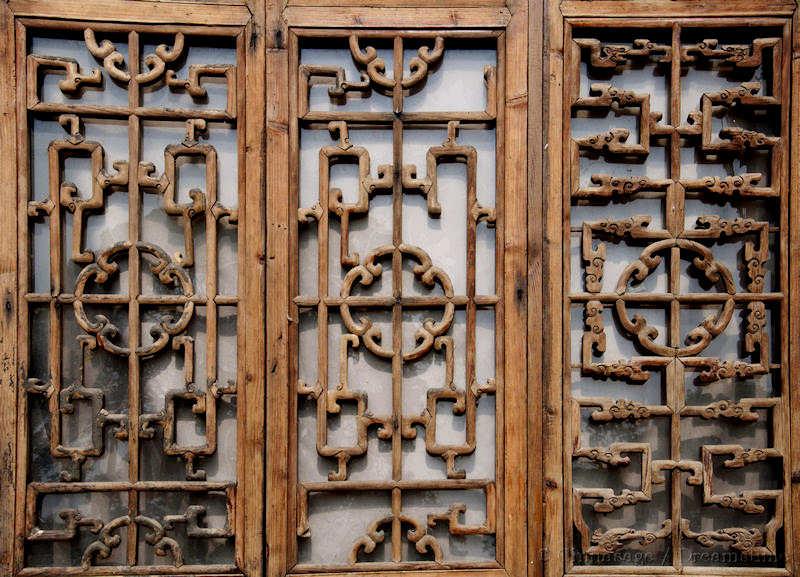
As the use of window glass was pretty much unknown in China until the 20th century, windows were covered in waxed paper or silk in winter (to keep out rain and cold) and left uncovered in summer (to let in cooling breezes). Often only the south side of buildings would have windows. The window frames were decorated with intricate, wooden lattice-work designs. Because the geometric design motifs changed over time and region, they can be used to both date the building and deduce the location within China.
House construction in China
As China is subject to violent earthquakes it was not safe to build a high stone or brick building. The internal walls and screens within the building were not load-bearing and could be easily taken down and rebuilt to reflect the changing needs of the family. Brick was used for city walls and fortifications in China but not in house construction, instead wattle and daub was used for ease of removal and construction. It has only been with the use of re-enforced concrete that the erection of high-rise buildings has been possible. Sturdy wooden pillars can withstand earthquakes ➚ better than stone walls. Indeed in a relatively recent earthquake it was only the traditionally built village temple ➚ that survived unscathed.

Each building (建筑 jiàn zhù) around the courtyard was laid on a solid stone or brick base. The base was often raised a couple of feet to prevent the possibility of flooding. On the base are placed the main wooden supporting pillars set onto stone pads. The pillars are tenon jointed by cross-beams in both directions. High status buildings used pillars made from 楠木 nán mù wood - a tough straight conifer from southern China. Traditionally an even number of columns are used to provide an odd number of bays. The bays between the pillars was a standard 间 jiān length and a ‘jian’ was used as a measure of distance.
Although the wooden pillars have no capitals the pillars are attached to the roof with elaborate wooden brackets (斗栱 dǒu gǒng). These dougongs became more elaborate over the centuries and they can be used to date a building. The bracket arm length was a standard proportion of the whole building and all the timbers were cut in multiples of this unit size. The interior and exteriors walls are not structurally important or load bearing, it is the pillars that take all the weight of the roof.
In terms of color scheme for the house, the base was white and the pillars red with blue eaves and for Imperial buildings it was topped by yellow tiles.
Roof

The traditional roof is constructed by laying diminishing lengths of roof timbers fixed on top of each other with purlins at the ends. The whole roof rested on a series of orthogonal timbers that ran between the evenly spaced pillars. The timber was jointed rather than nailed together. A cantilever arrangement was used to support over-hanging eaves. The whole roof was covered with alternating layers of loose concave and convex terracotta tiles, although in rural areas thatch was used. The ceiling beneath could be flat or vaulted. In the design of roofs there is a key division between northern and southern China. In the north, roofs have to cope with a heavy burden of snow while in the south more shade is needed so southern roofs are more curved and elaborate. These roofs may have the eaves so curved that the outer corners point upwards (flying eaves) and reach the same height as the top of the roof. It is likely that roofs in Burma and Thailand influenced this style.
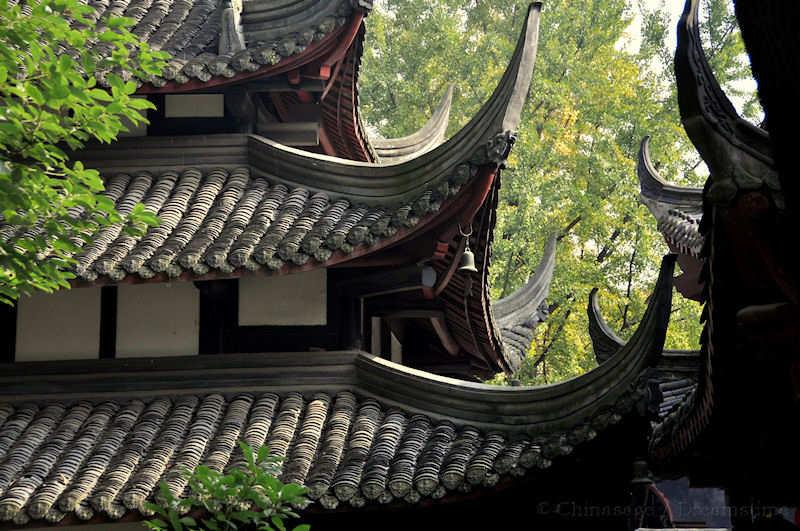
The roof ridges often have glazed terracotta figures of deities and animals including dragons and a man riding a hen; these brought luck to the house and its occupants. The more prestigious the house the more creatures there are on the roof ridge. More than one legend attempts to explain the end figure, the man riding on a hen ➚; it probably symbolizes ‘impossibility’ as a man can’t ride a hen, and a hen can’t fly; so the figure is therefore doubly rooted there and protects the roof and house. Alternatively it may commemorate the tale of Prince Min of Qi ➚, a cruel tyrant tied to the end of the roof 2,200 years ago. Other figures on the roof ridge may include the chīwěn 螭吻 a hornless dragon for protecting the building against fire (as dragons control water), phoenixes, qilin and other mythical beasts. In the Ming dynasty there was a standard ordering of the protective animals: man on hen, dragon, phoenix, lion, qilin, horse and chiwen (always an odd number). High status houses have decorated finials at the end of each row of roof tiles as well as a pair of dragons on the ridge of the roof.

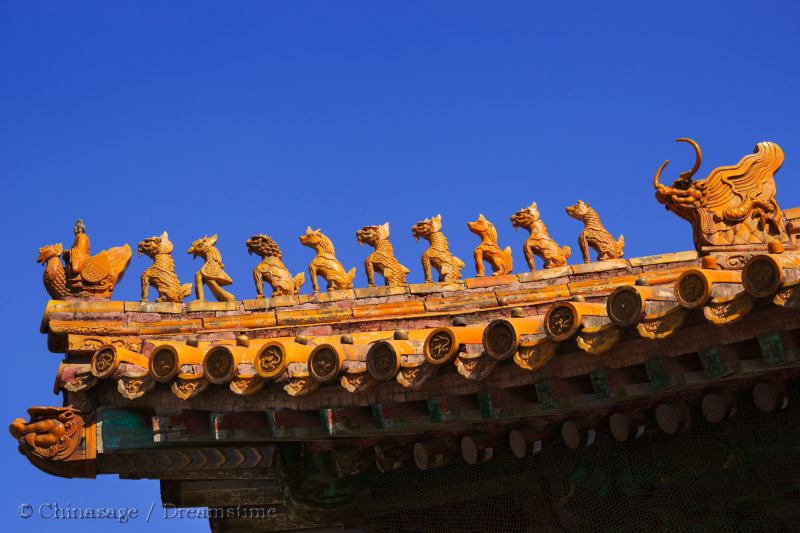
Chinese Gardens

For all but the poor the center of the courtyard was laid out to garden. While the buildings are geometrically regular, the gardens are irregular offering a naturalistic vision of the countryside beyond. This represents a quest for yin-yang balance where the regular and geometric walls and buildings are yang while the garden is yin. Winding paths; glazed plant pots; water and rocks are important elements of the traditional garden. Water is an important unifying feature and pools are often stocked with goldfish. Strangely shaped, irregular rocks have been collected and showcased in gardens for centuries. There is variation across the regions of China in the garden design and there is scope for individuality in design too. The city of Suzhou in Jiangsu is famous for its ancient gardens. However, for poorer folk the garden was a patch of ground for growing vegetables and herbs for the pot.
The informal and naturalistic garden Chinese designs heavily influenced European garden design in the 18th century, Europe had for a long while chosen geometric designs totally different to the Chinese model. Chinese gardens do not have areas laid out to grass lawns. This is partly due to the dry climate but mainly because a mass of green would not create a pleasing balance. The absence of space for trees is made up for with 盆景 pén jǐng (the Chinese form of bonsai) trees growing in containers.
A feature of the grander gardens are moon gates 月门 yuèmén which is a circular gateway that offers an impressive view (with privacy) of another section of the garden. The division of gardens into compartments was greatly admired by westerners and is still the root of grand garden design.
The first visitors to the Old Summer Palace in Bejing were greatly impressed. John Barrow visiting in 1793 wrote “… The Chinese add the very great advantage of abundance of canals, rivers and large sheets of water whose banks, though artificial, are neither trimmed nor shorn nor sloped like the glacis of a fortification, but have been thrown up with immense labour in an irregular and, as it were, fortuitous manner so as to represent the free hand of nature. Bold, rocky promontories are seen jutting into a lake, and valleys retiring, some choked with wood, others in a high state of cultivation. In particular spots where pleasure houses or places of rest and retirement were erected, the view appeared to have been studied. The trees were not only placed according to their magnitude but the tints of their foliage seem also to have been considered in the composition of the picture… Nothing that I saw could be considered an offence to nature.”
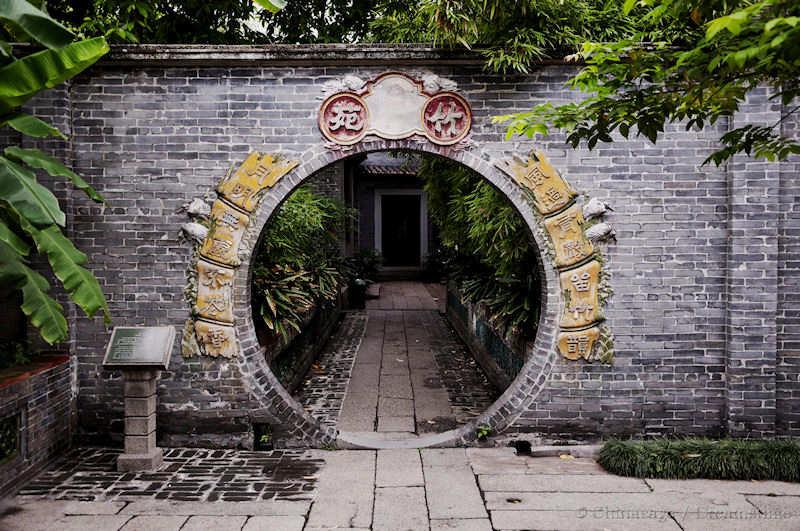
Town Planning
Individual houses although fairly uniform in design need to be arranged into a whole town or city.
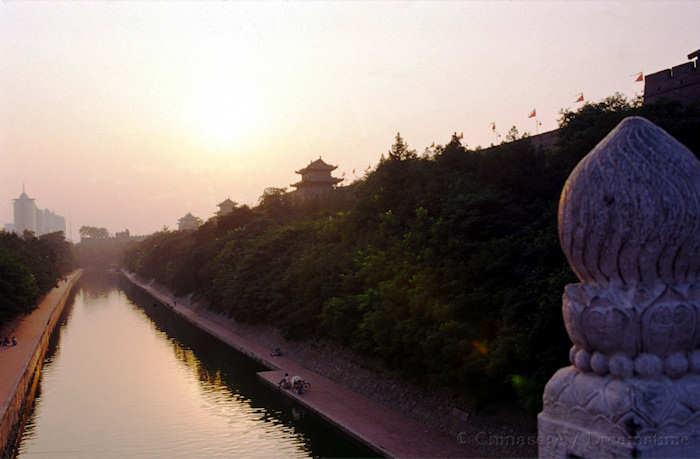
Town walls
Over many centuries Chinese towns were laid out to a standard plan. They used a grid pattern with the whole town surrounded by a high earth wall and often a moat. The wall was considered so important for the community that the character for ‘city’ 城 chéng is the same as the one for ‘city wall’. The wall acted as a defense against nomadic incursion and also flooding; it is made from hard clay that is faced and topped with specially made large bricks. A wall typically tapered from 40 feet [12 meters] up to 25 feet [8 meters] in width and over 60 feet [18 meters] high. The walls had grand, brick corner towers with cannon mountings for defense. Some had buttresses built against the wall at regular intervals for extra protection and solidity. Cities in the south had smaller defenses, with lower walls and narrower gates reflecting the reduced fear of nomadic raids in the more mountainous terrain.
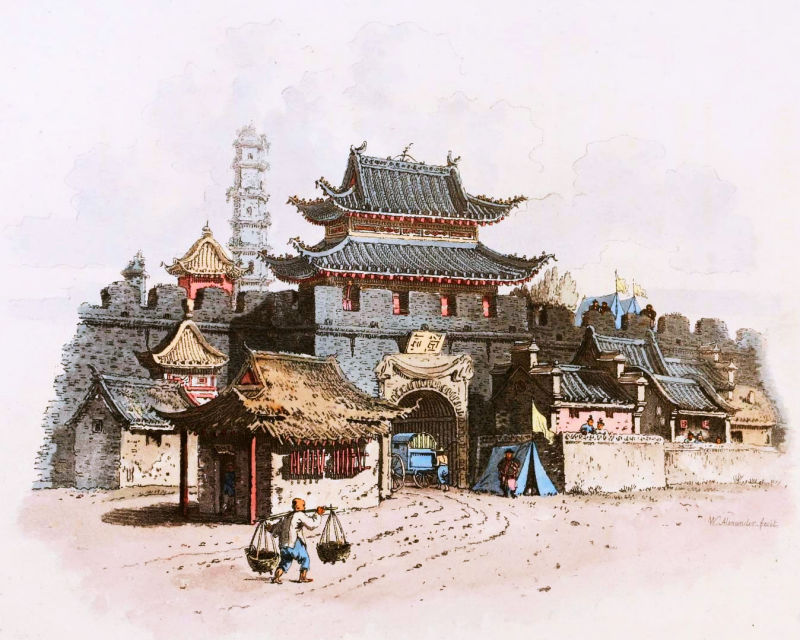
Gates
Entry to the town was through gates often aligned with the compass points. The city gates were locked at night. The gate towers were three story buildings of wood with tiled roofs and as they stood on the high wall were about 100 feet [30 meters] above the ground. The town interior had only a few multi-story buildings near the center and so the town lay completely hidden behind the city wall. The design of the town placed all the important buildings along the principal, long avenues rather than grouped at the center.
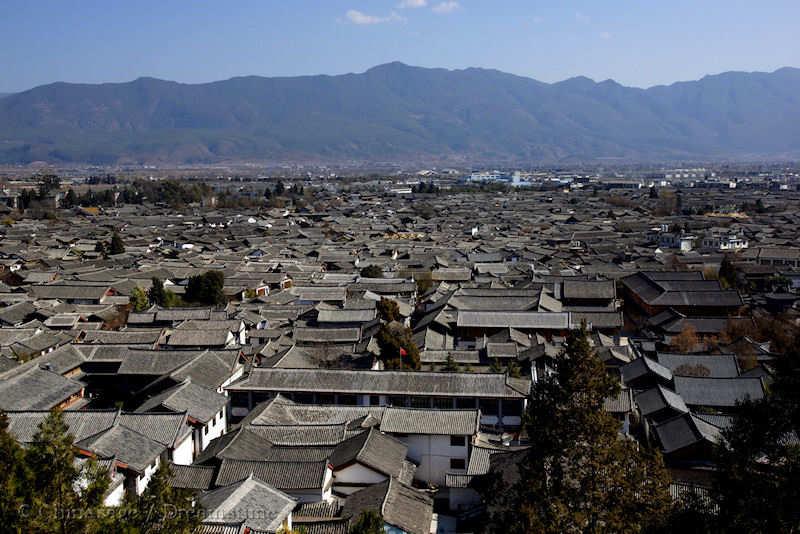
In the north of China there were two axes dividing the city into four quarters with four gates where they met the outer wall. The gates of the larger cities tend to be grander and taller. In the Han dynasty large towns were symmetrically sub-divided into districts of a hundred houses; each district had its own wall and its own gates. The market area was normally to the north of the town surrounded by the houses of the merchants while farmers lived near the gates. All gates were guarded at night and a curfew imposed - everyone had to be back in their own district. Normally rich and poor lived close together and were not segregated. Within the district the layout was unplanned and over centuries created a random assortment of houses of different sizes and ages, separated by meandering narrow lanes, in Shanghai called longtangs ➚. In Beijing they were laid out as a stricter rectangular grid and called hutongs.

Central towers
Near the center were the Drum and Bell Towers, which rise to two or three floors so the sound could be heard over the whole town. One of the best surviving examples of these are at Xi'an, Shaanxi. A drum tower stood over the central crossroads and so could quickly limit any disturbance or external attack to just one quarter of the city. The drum was sounded at sunset and midnight to mark the passage of the night. The time was measured out at night by the burning of calibrated incense sticks or a clepsydra ➚ (water clock). In Beijing the drum was struck 108 times (9x12 times). The bell tower sounded out at 7pm and 5am each day, again it was rung 108 times, it signaled when people should go to bed and get up in the morning. In the days before electric light only the very dedicated would study by oil lamp into the night. In some cities the bell was struck on the hour during the day and the drum on the hour during the night.
During the Tang dynasty when China had the largest cities in the world, the same layout was used but on a grander scale. Luoyang the capital covered 19 sq miles [49 sq kms] with major avenues 500 feet [152 meters] in width. The city enclosed areas for recreation and farming not just housing.
Yamen 衙门 yá men
One of the grandest houses of a town built in the courtyard style was the yamen (衙门 yámén) where the town's administrator (often translated as magistrate) lived and worked. As this was an Imperial appointment and the official was usually relocated from far away (as a measure against corruption) he lived at the yamen with his family for a term of three years. It was to this house that people would come for help and seek justice. The courtyards would include the prison cells and a main hall for holding audiences.
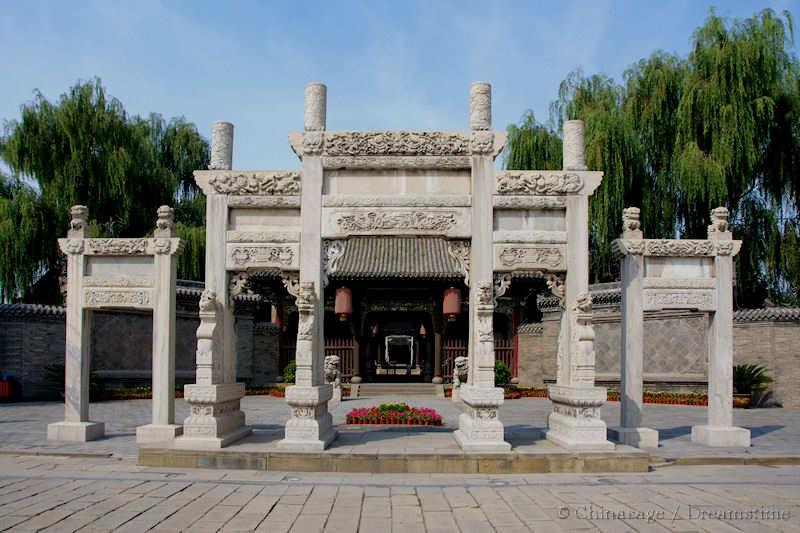
Rural housing
The housing of the rural peasants were scattered over the countryside on the smallholdings where the families farmed and not in villages. In the low lands these were made of blocks of baked clay, or wicker-work plastered with clay. The roofs were of straw or sometimes turf. The peasants kept pigs, ducks and chickens around and inside the small cottages out in the fields.
In the loess lands of Shaanxi and Gansu many people lived in caves dug into the soft loess cliffs. They are warm in winter and cool in summer. In the cold north, heating was usually provided by a brick built 炕 kàng, over the flue of a wood burning stove. Beds were made on top of the kang for the night and seats during the day.
Historic Beijing
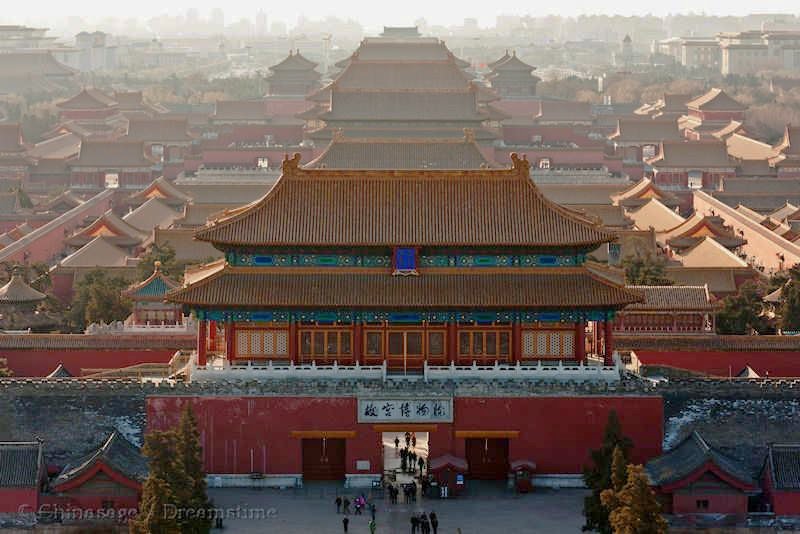
When Beijing became the national capital during the Yuan dynasty the city was laid out from scratch. The overall design by Liu Bingzhong was based on the ancient Zhou dynasty text 考工记 Kao Gong Ji The Records of Examination of Craftsman ➚ as a grid of 9x9 avenues with two or three gates on each side rather than one. The City Wall had nine story pavilions over each gateway housing a defensive guard and cannon. Each gate was used for a specific purpose; the ‘Gate of Virtue and Victory’ on the west of the north side 德胜门 Dé shèng mén for the dispatching of armies; ‘Gate of Certain Peace’ on the east of the north side 安定门 ān dìng mén (for carrying for transporting night-soil out to the fields and sewage farms); ‘Eastern Upright Gate’ on the north of the east side 东直门 Dōng zhí mén which carried in wood transported on the Grand Canal; ‘Gate of the Rising Sun’ in the middle of the east side 朝阳门 Cháo yáng mén through which grain was transported from the Grand Canal into the city granaries; ‘Gate of Sublime Learning’ on the east of the south side 崇文门 Chóng wén mén through which wine was transported; ‘Gate of the Righteous Sun’ in the middle of the south side 正阳门 Zhèng yángmén for the Emperor's sole use; ‘Gate of Majesty of Arms’ on the west of the south side 宣武门 Xuān wǔ mén through which condemned criminals were sent for execution; ‘Gate of Abundance’ on the south of the west side 阜成门 Fù chéng mén for the import of coal for heating and ‘Due West Gate’ on the north of the west side 西直门 Xī zhí mén for the import of fresh water for the Emperor's use. In later years additional gates were added.
The Forbidden City built 1406-20 in the early Ming dynasty formed the inner block with its own moat and wall, forming a city within the city and so is doubly protected. To provide the very best feng shui, the material dug from the moat was built up to form Jingshan or Coal Hill 景山公园 to the north of the Forbidden City. The enclave has four gates: one on each side and a defensive tower at each corner. The gates are the 午门 wǔ mén (Meridian Gate) on the south (where the calendar was proclaimed and military forces reviewed); 神武门 shén wǔ mén (Gate of Military Genius) to the north; 东崋门 dōng huá mén (Eastern glorious Gate) near the southern end of the east wall and 西崋门 xī huá mén (Western glorious Gate) near the southern end of the west wall.
The Imperial Forbidden City admirably demonstrates the nesting of courtyards within courtyards on a vast scale. The impression is of an infinite maze of similar courtyards, but each had its specific function spread over 700 acres. The lack of multi-story buildings adds to the sense of claustrophobia as there were no high buildings to give a clue to your location within the sprawling complex.
During the Qing dynasty the Inner City of Beijing surrounding the Forbidden City was occupied by the Manchu nobility divided into eight districts according to their banner system of clans. The Han Chinese lived in their own city area to the south separated by a wall. The Beijing city avenues were 118 feet [36 meters] in width; streets were 59 feet [18 meters] in width and lanes (hutongs) were 30 feet [9 meters] wide. The individual districts were continually rebuilt over time which caused them to become meandering and narrow that gives them their characteristic charm.
Only a few parts of Beijing's original city wall and moat can be seen today, with the inner ring-road now following the line of the old walls which were demolished in the 1950s, as Beijing has greatly expanded beyond the original size. Of the original great gates into the city only Dongbianmen Gate remains. However the central Drum and Bell towers do still stand. In the early days of the Peoples Republic much of the traditional housing was replaced by modern blocks of apartments. A small proportion of the old-style housing has become formally protected. These old 'hutong' districts are now popular with tourists.
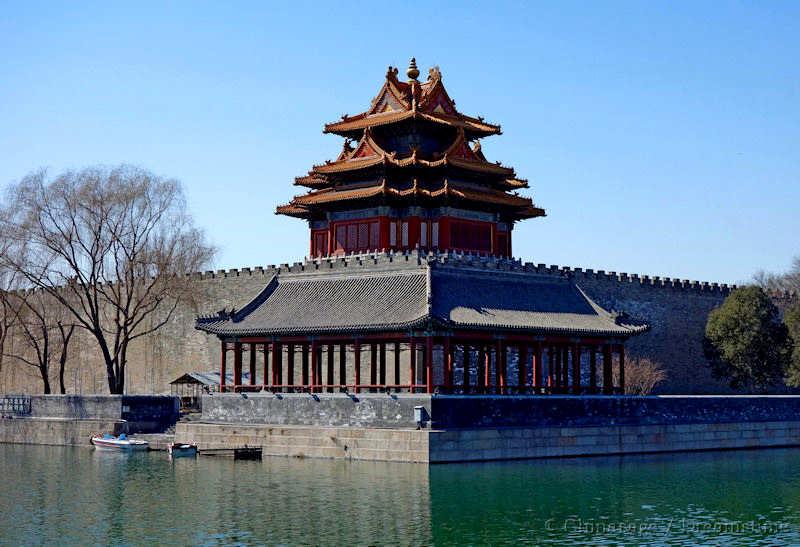
Modern Chinese Design
European architecture came into China with the Jesuit Missionaries in the late Ming dynasty. They brought with them the latest engineering and architectural designs. This developed further in the early Qing when the Jesuit missionaries built a windmill and a fountain for Emperor Kangxi. Emperor Qianlong also had palaces built in the European style. However this was probably more to do with collecting ‘exotic’ building styles rather than influencing traditional architecture. A few of the stone buildings of the Old Summer Palace (Yuan Ming Yuan) built in the late 18th century to early 19th, reflect this trend. They were storehouses for European paintings, scientific instruments, curiosities and gifts of all kinds from foreign lands. Some of the gardens also reflected European style.

Since the foundation of the Peoples Republic the first architectural influence was from the USSR (Russia). During the 1950s many gloomy, square, brick and concrete buildings were built under the guidance of Russian architects and planners. Since the 1980s a modern, international design style has permeated throughout most of China. Planners in recent years have turned to innovative world architects and the city skylines are now graced by many novel and 'international' designs. The rate of new construction is incredible, sweeping away much of the old housing, in 2004 China consumed 55% of the world's concrete and 36% of the world's steel in this race to modernity.
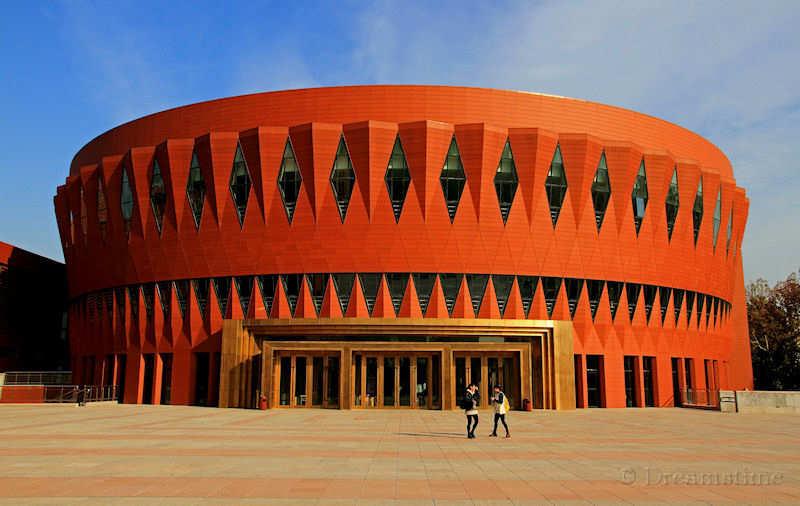
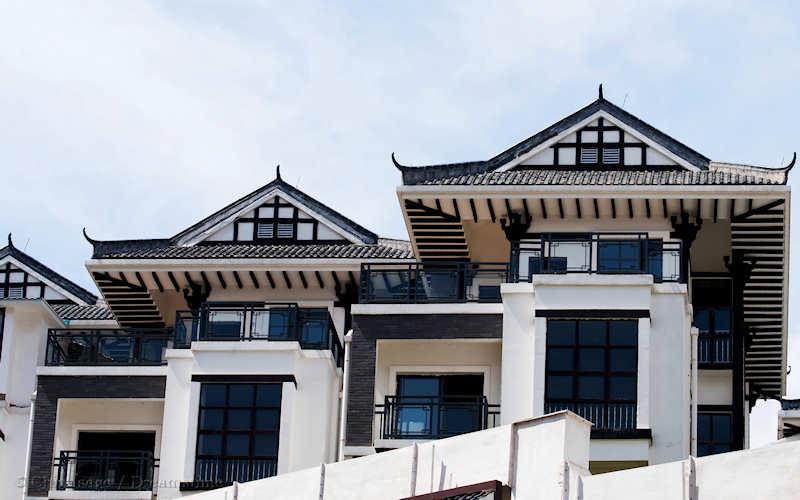
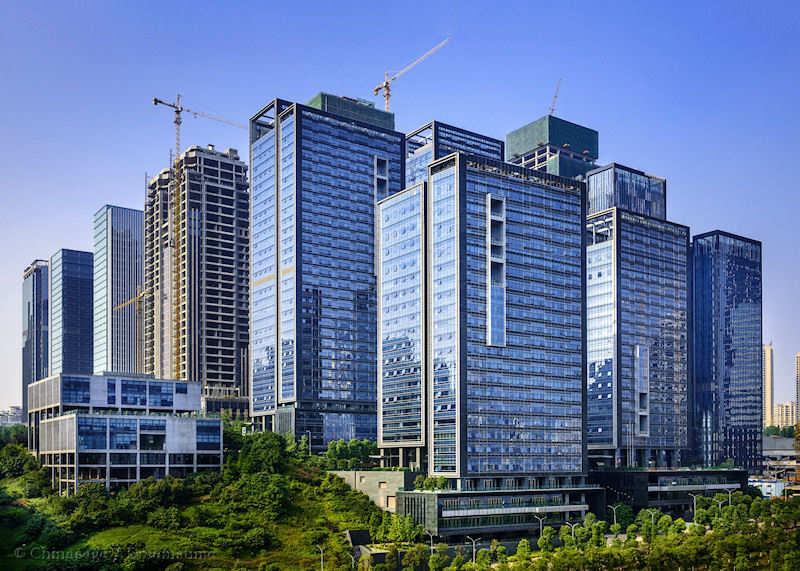
Other constructions
Chinese Tombs
Since Shang dynasty times Chinese tombs have been mainly underground. The format reflects the design of houses, because of the belief that a tomb is a house for a continuation of life after death. It was laid out to offer familiarity of layout and was provisioned with food, tools and everything else a living person might need.
Feng Shui is extremely important for the location of the tombs. From the Han dynasty onwards a central chamber is covered by a burial mound (tumulus). It has a long sacred or spirit way leading to it lined with statues, steles (inscribed stones often a eulogy) and pillars. The Ming Tombs at Beijing are the largest and most lavishly designed.
A decorative pillar (华表 huá biǎo) is a common feature around palaces and tombs. Originally in wood these highly decorated constructions often have a mythical beast on top with a cloud design. There are four marble huabiao around Tiananmen Square - two look south from the palace and two look north. Another set of four surround the Stele Pavilion in the grand entrance to the Ming Tombs. On top is usually a 蹬龙 dēng lóng a type of dragon with the features of several animals.
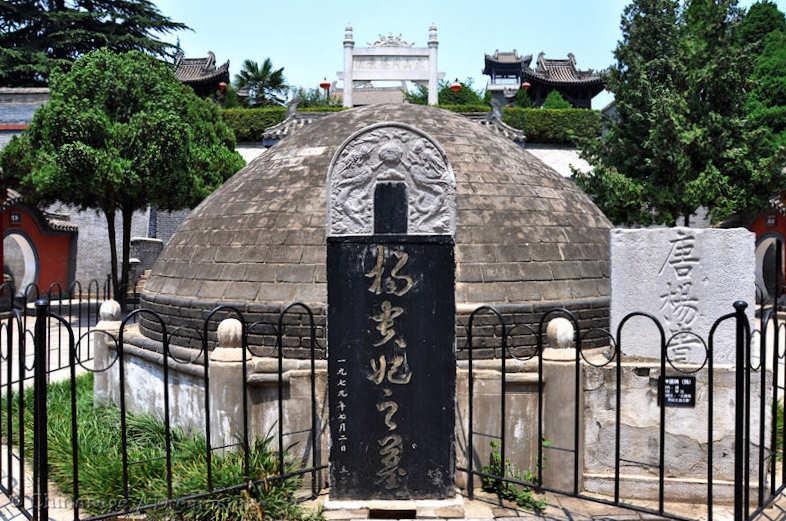
Archways
Decorative archways have been a feature of Chinese architecture for centuries; they commemorate prominent officials; widows and Imperial officials. They are built of stone and have one; three or five arches.
A 牌坊 páifāng (or 牌楼 pái lóu for the grander gates) was often built at the entrance to the tomb often with white marble uprights and wing-like projections (often decorated as clouds). The lintel would be inscribed with the accomplishments of the deceased.

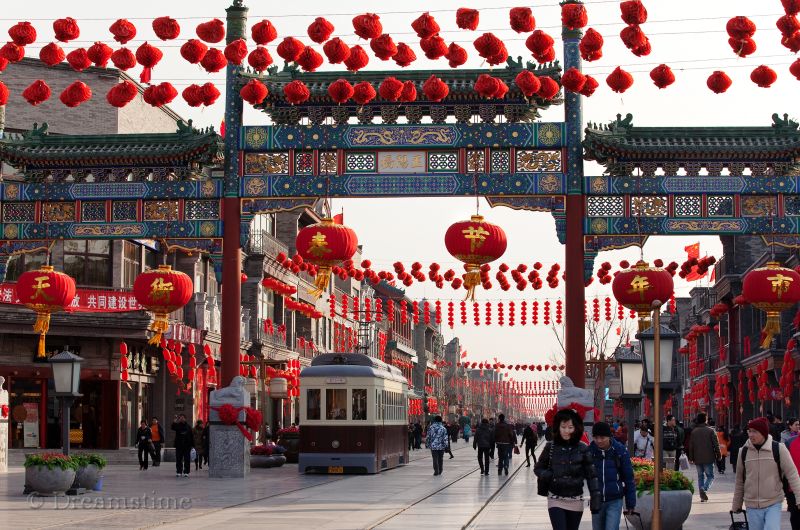
Bridges
The oldest single span arched stone bridge in the world is at Zhaozhou (Anji), Hebei (605-617CE) demonstrating that the Chinese had mastery of curved arches from an early date. The use of arches is restricted to bridges and gateways and is not normally used in domestic buildings. Other bridge types include the simple flat beam and the suspension bridge which often used iron chains.

Temples
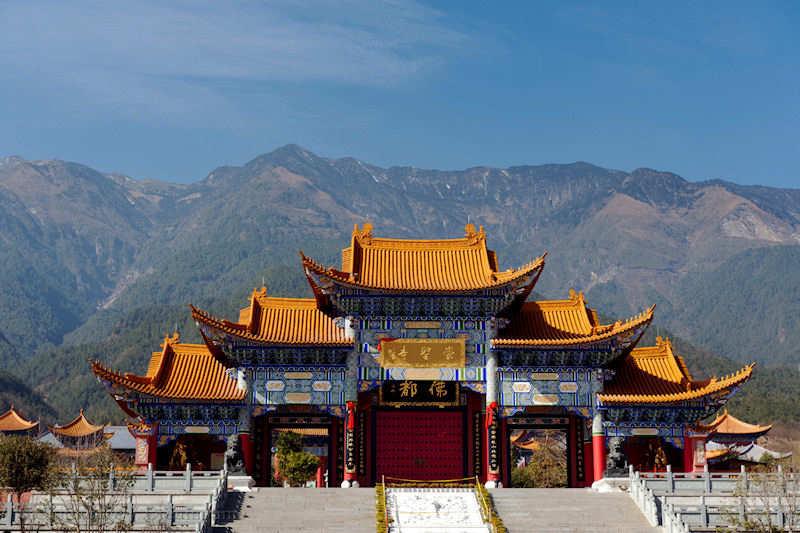
The traditional Chinese temple is constructed as just a grander form of the normal private courtyard house and were often built taller. The architects and builders who built ordinary houses would construct the temples. As the 'courtyard' structure was so standard, houses and temples could be built without needing an architect or surveyor. The main temple buildings are in the front with the domestic quarters behind. Temples are more associated with Confucianism (庙 miào) than Daoism that has less need for temples. The front enclosure is often protected by guardian stone lions 獅 shī.
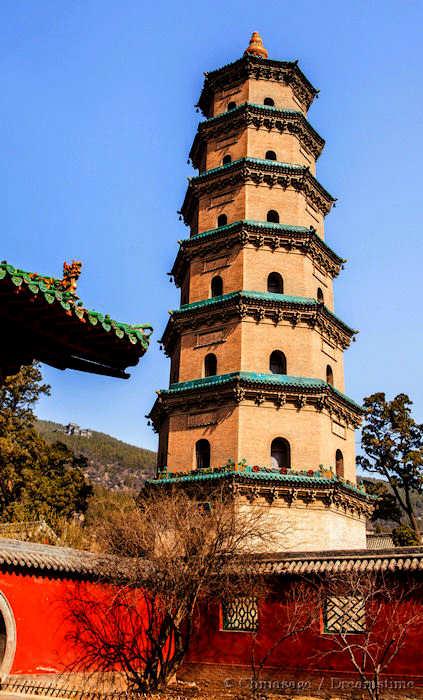
Pagoda
Although the many-storied pagoda (塔 tǎ ) is associated with Buddhism, its origin seems to be from early Han towers rather than originating from India. Pagodas act as storehouses of sacred relics or commemorate a sacred place. They always have an odd number of stories - often nine or seven. They are certainly one of the most quintessential features of the Chinese landscape; paintings and porcelain often show a pagoda as a shorthand for saying ‘this is a Chinese landscape’. They are often built when the flow of qi was weak according to the rules of Feng Shui. They are built with a double exterior wall with a staircase running up between the two walls.
Early pagodas were built of wood and have not survived, it is only the stone built pagodas that can still be seen today. A twelve sided brick pagoda from 523CE is at Songshan temple, Henan. Another early example with seven stories is the Big Wild Goose Pagoda (大雁塔 dàyàntǎ) at Xi'an that was founded in 652 to be partially rebuilt in 704. Near the Shaolin Temple in Henan is a collection of small (a few feet high) pagodas called 塔林 tǎlín - ‘forest of pagodas’ as memorials to individual monks. The finest pagoda was the Porcelain Tower ➚ in Nanjing during the Ming dynasty, destroyed in the Taiping Rebellion but now recently rebuilt at great expense.
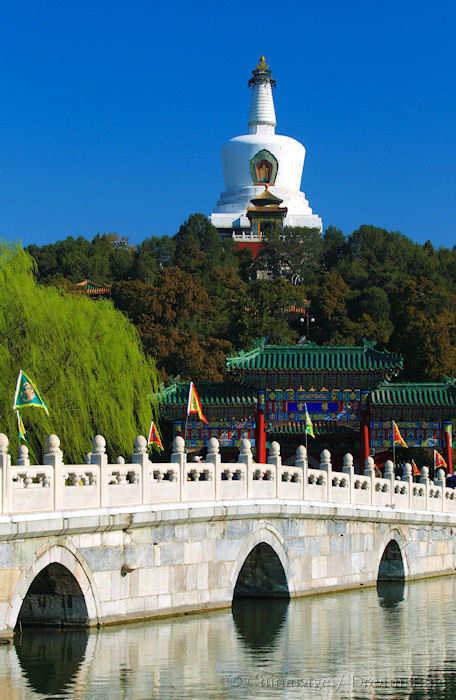
The Dagoba (Dāgaba) comes from the Tibetan form of Buddhism in the form of squat stupa ➚ built for housing sacred texts. They came into fashion during the Qing dynasty when all things Tibetan were the vogue. The best known example in China is the large White Dagoba in Beihai Park, Beijing.

Pavilion
Rather like the pagoda, the pavilion is a familiar building in Chinese landscapes. They are usually of one or two floors and often located by lakes in southern China. Many villages had small pavilions to give protection to travelers from the elements, and as such were the scene of many amorous encounters. High ‘flying’ eaves often decorate the roofs.

Islamic mosques 寺 sì in western China follow the central Asian/Persian style, but further east, where Han people predominate, Hui people in central and eastern China have built mosques in the traditional Chinese temple style.
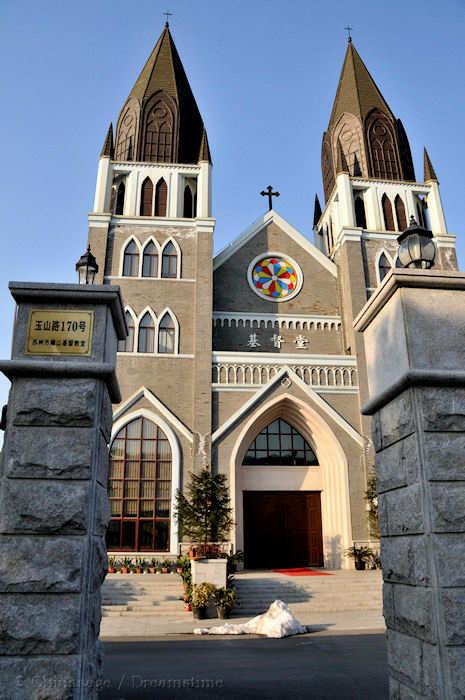
Christian Churches were built by western missionaries in the European style with little reference to the local vernacular but modern churches follow more traditional Chinese architecture.